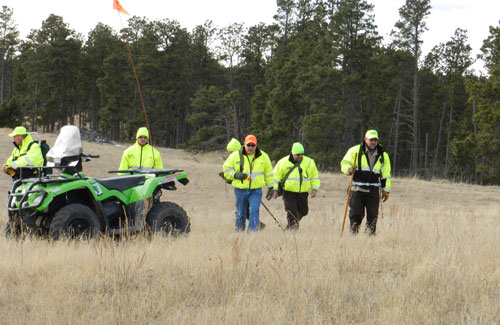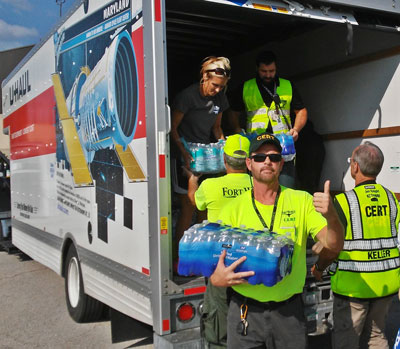Neighbors Protecting Neighbors
The Transportation Work of Community Emergency Response Teams

Members of Scotts Bluff County Community Response Team (CERT) help search for a missing person.
When a wildfire began rapidly spreading through Willow, a rural area about 70 miles north of Anchorage, Alaska, in 2015, a team of volunteers was called to assist first emergency responders by keeping roads clear for emergency vehicles, staffing a shelter and helping evacuate thousands of people and animals.
The volunteers are members of Willow’s Community Emergency Response Team or CERT, a program run by the Federal Emergency Management Agency (FEMA). CERT programs educate volunteers about disaster preparedness and train them to assist first responders during emergencies. Willow’s team was established in 2006 and had been used during floods, but the fire was the first time they were needed for an extended period.
“I call it a baptism by fire for our team,” said Brenda McCain, a Willow CERT team leader, who added that they assisted for 10 days.
Across the United States there are more than 2,700 active teams, with more than 600,000 members who have received training since 1993. Team members range in age from teenagers to senior citizens. They’re trained in fire safety, light search and rescue, and disaster medical operations. The teams help secure police perimeters, inform residents about hazardous road conditions, and direct pedestrian and vehicle traffic.
CERTs can play a critical role in keeping roads clear for emergency vehicles and assisting with disaster shelter traffic management, as the Willow team did during the Sockeye Fire. Many teams are trained by professional first responders, including firefighters, police officers, sheriff’s deputies, emergency medical technicians, and officers of the American Red Cross.
Dr. Rodric Bowman, the regional disaster officer for the American Red Cross New Jersey Region, said the volunteers are a valuable community resource.
“They’re dedicated to their community,” he said. “They give back and support the people that they serve. That gives them fulfillment and pride in their community.”
Teams augmented professional first responders’ work during New Jersey’s late 2017 and early 2018 winter storms, and during Superstorm Sandy in October 2012, he said.
Team members undergo the same shelter management training as Red Cross staff.
“We’re about collaboration,” he said. “Partnering with CERTs is critical to our operations.”
Starting a CERT
Teams are often organized when a natural disaster overwhelms a region’s first responders.
The Molalla Fire District, a rural area south of Portland, Oregon, decided to sponsor a team about 3½ years ago to supplement its three-person staff, Lt. Bryron Wakefield said.
“Our fire district is just over 100 square miles. In the past few years, we’ve had major wildfires,” he said. “The CERT meets and trains at the fire station. Right now, they’re under our umbrella.”
When the Sockeye Fire began, the Willow CERT had been meeting regularly for a few months and was prepared when the Red Cross called seeking help staffing an emergency shelter.
There the team worked with many agencies and individuals who spontaneously volunteered to receive a high number of people and pets — more than 1,000 sled dogs on the first day alone, and chickens, rabbits, cats, and horses. Willow is known as the “dog-mushing capital of the world” because the 1000-mile Iditarod and other sled dog races start there.
“There are as many dogs as there are people here,” McCain said adding that chaotic scene was compared to Noah’s Ark.
CERT members were tasked with keeping traffic away from the ambulances in the community center parking lot so they could exit immediately if dispatched. They also assisted with the registration desk and in the kitchen to prepare food for evacuees and first responders.
Team members who couldn’t get to the center were used to manage traffic on the main road.
The importance of training and organization
CERT members typically undergo a minimum of 20 hours of training, and usually meet monthly to engage in exercises to prepare for various disasters.
Wakefield said it can be a challenge to keep everyone engaged when they aren’t regularly responding to disasters. One way Molalla Fire District tries to keep training interesting is by focusing on the unique skills the various team members bring to the group.
In addition, community events —parades, festivals, and those involving law enforcement — serve as opportunities to train teams to manage pedestrian and vehicle traffic.
Bob Hessler, CERT coordinator in Scottsbluff, Nebraska, said every summer team members assist law enforcement officers during the Scotts Bluff County Fair.
He said the professional firefighters and EMTs handle the more challenging tasks and the CERT volunteers assist with things like keeping crowds from bottlenecking and stopping.
Scottsbluff Police Chief Kevin Spencer said the CERT help direct traffic at seven or eight parades each year.
“They’re focused and no nonsense,” he said.
Responding to Emergencies
When a tornado struck in Bayard, Nebraska in June 2017, the Bayard Secondary School CERT was prepared. The team, created in 2013, includes students in grades seven through 12.
“The morning after the tornado, the students walked throughout the town on foot. They went door-to-door, checking on every resident in town,” Travis Miller, superintendent of Bayard Public Schools, said.
Adults train the students to plan fire escape routes in their homes, locate adequate water sources, put out fires, and offer light medical triage.
“The high school students have emergency preparedness bags in their cars. In the summer, we have them take the bags home. When the students graduate, we encourage them to join the adult CERT team or become EMTs,” Miller said. “These kids are just amazing.”
Fort Worth’s CERT team helped during Hurricane Harvey, which hit Dallas-Fort Worth in late August 2017.
 Officers Phil Woodward and Thomas DeLong, the CERT coordinators for the Fort Worth Police Department, said volunteers provided around the clock assistance for 28 days after the storm. In addition to 25 Fort Worth CERT members, 68 volunteers from other teams and agencies pitched in to help the Red Cross open a shelter at the Wilkerson-Greines Activity Center.
Officers Phil Woodward and Thomas DeLong, the CERT coordinators for the Fort Worth Police Department, said volunteers provided around the clock assistance for 28 days after the storm. In addition to 25 Fort Worth CERT members, 68 volunteers from other teams and agencies pitched in to help the Red Cross open a shelter at the Wilkerson-Greines Activity Center.
“We accepted 240 evacuees. All of them had to undergo a background check. We enrolled all of the kids in school,” Woodward said.
CERT members created a traffic plan for the shelter parking lot, which helped facilitate school buses picking up students.
“CERT members also brought in evacuees with disabilities from public transit buses and got evacuees to doctor’s appointments,” DeLong said. “Altogether the volunteers involved in operating the shelter logged about 3,200 hours of volunteer work.”
In 2013, the City of Longmont, Colorado, saw how a CERT could help its Office of Emergency Management.
That September, the St. Vrain River flooded large portions of the city, which lies across Boulder and Weld counties. When the floods hit, first responders who lived in nearby areas were cut off from reaching residents in low-lying parts of the city. After the city recovered, it held community meetings to gather feedback about the city’s response and discuss what community service members could do to be better prepared in the future.
“Residents wanted somehow to be better trained for the next time. We started our first CERT in 2014. We maxed out the number of signups for that first class,” said Peter Perez, Longmont’s emergency management analyst.
The team now has between 30 and 40 active members who are able to OEM staff the building, answer the phones, and provide necessary information to residents when staff are needed for other things during a disaster, Perez said.
Ron Collins, a Longmont CERT team instructor and member, said the floods were one of the reasons he signed up four years ago. Now CERT members can be called to help with evacuations, among other things.
“We are equipped to send CERT people out to knock on the doors, notify residents of an evacuation, and allow them to self-evacuate. Its neighbors helping neighbors,” said Collins.
Collins said the Longmont CERT is also unique in another way. One-third of the group has wilderness first aid training.
“Wilderness first aid is different from regular first aid because it prepares you for a long delay between the incident and medical care. Having that many people trained in wilderness first aid provides an added layer of safety, particularly for an event that can make a difference between people dying and not dying,” said Collins.
Tools and resources
CERTs do better when they are prepared for the digital age and well-equipped. McCain said that the Willow CERT has stayed together partly because email, smartphones, and social media aid communication.
Grants have helped the team provide training. After the Sockeye Fire, 17 team members received professional traffic management training and became nationally certified flaggers thanks to a $1,600 grant from Willow’s Community Council. Grants have also paid for CPR and first aid training.
One of the most important skills a CERT member can have is ham radio operation because the radios work even when landlines and cell phones fail. CERTs across the country encourage ham radio operators to join their ranks.
“Each CERT member carries a radio tuned to a special frequency. It’s strictly for disaster response,” Collins said.
Miller said at first, he didn’t want to spend money on radios, but he’s glad he did. When the school lost power and phones were down, they were able to contact student members by radio.
“Once we started reaching the kids, they got in touch with each other and activated themselves,” Miller said.
Building on public interest
Natural disasters and tragedies often help raise awareness and generate interest in joining a team.
Collins said he joined the Longmont CERT following the September 11 terrorist attacks.
“For six years, I worked in the second tower of the World Trade Center. I had just switched to a Park Avenue office before September 11, 2001. I have an interest in disaster preparedness and response based on that experience,” said Collins.
Interest in the Fort Worth team grew after Hurricane Harvey, DeLong said.
Community events also help with recruitment. Woodward said CERTs that showcase themselves and their skill sets are more successful in encouraging members of the public to sign up. Their team assists with 10 major events, each attended by more than 10,000 people.
“On top of that, we attend four-to-six smaller events every year and recruit for our CERT unit,” he said.
Attracting new members is key for every team. Retirees are often active members, but sometimes they must leave for family or health-related reasons.
Wakefield encourages all CERT members and first responders to get members of the public interested by talking to others about what they accomplish.
“They train people to take care of themselves and take care of their neighbors, he said. “That eases our burden in time of a disaster.”